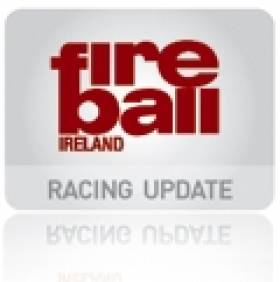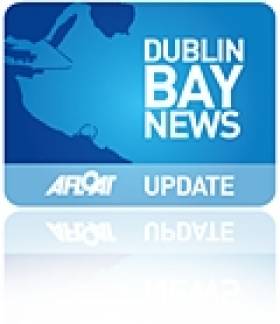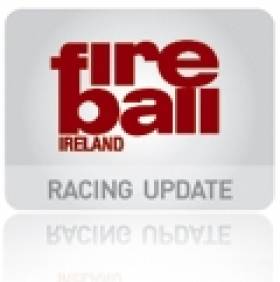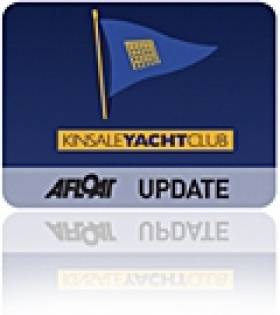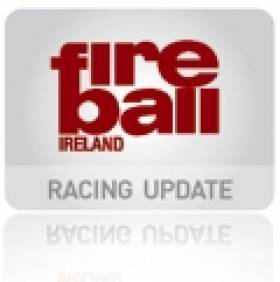Displaying items by tag: Frostbite
Fireballs Break out of the Harbour For Dun Laoghaire Frostbite
#fireball – The third Sunday of the 2014/15 Frostbite Series saw the fleet break out of the constraints of Dun Laoghaire harbour and race offshore yesterday writes Cormac Bradley. My interaction with the fleet afterwards suggests that the dominant feature of the day was the big sea running outside the harbour, which combined with a light-ish breeze, gave everyone a bit of a challenge.
A five lap trapezoid course was set with a separate weather mark for the Fireball fleet. My contacts also suggested that there was a lot of place changing going in the bottom half of the fleet, but couldn't offer a "blow by blow" account of what was going on ahead of them.
However, I was told that for the second week in a row, a member of the fairer sex became detached from her boat and had to be rescued by her (female) crew. Well done Hermine! The previous week, in zero wind, another all lady team capsized while they floated around waiting for the wind to fill in..........which it never did. Oops, Mary & Brenda!
As I was not present to watch the racing and with it being offshore I might have had difficulty anyway, a detailed account of the racing is not available! Apologies!
However, I can surmise that with a finishing order of;
1. Kenneth Rumball & Brian Byrne INSC 15058
2. Conor & James Clancy RStGYC 15113 (adopted number)
3. Noel Butler & Stephen Oram NYC 15061
There would have been lots of fun and games at the front end of the fleet. Neil Colin admitted to being asleep at the start with his watch being a minute out, so he and Margaret (14775) spent the rest of the race catching up.
Alistair Court & Gordon Syme were pleased to find that their efforts had resulted in a 4th place finish.
With Rumball & Byrne also winning the first round race, yesterday's Frostbite Mugs went to the Clancy Brothers.
Irish Fireballers are reminded that the Class Prize-giving takes place on the last Friday of November, the 28th, in the National Yacht Club. In addition to awarding prizes for the season-long Traveller's Trophy, there are a number of Class Awards to be handed out – The Asterix Trophy, The India Trophy, The Captain's Trophy, The Lady's Trophy & The Liam Bradley Trophy. It is also an evening where the season-long post-mortems take place.
Hope to see you there! Please let a committee member know if you will be in attendance
Howth Yacht Club Wins for Quinn, Cull In Laser Dinghy Frostbite Series
#lasersailing – Thirty seasoned Laser sailors were greeted with a Westerly at 8knots at Howth Yacht Club for the second race of the 40th Laser winter series, slightly calmer conditions than last week! The Race Committee had their work cut out for them as both the wind and fleet were making things difficult.
After a General Recall, the fluctuating wind delayed the restart and eventually stabilized from a SW direction. Taking no prisoners, the RC went with a Black flag and needless to say managed to catch one over the line early! Half of the fleet went left and the other right. Things started to get tricky at the top mark with the boats from the right just edging out those from the left. A bunch that included Daragh Kelleher, Ian McSweeney, Oliver Keenan, Ronan Cull, Dave Quinn and Mike Evans all rounded in quick succession. Those who stayed to the left of the run or up tide managed to make some good gains and round the LW mark in good position. Sailors jockeyed for position throughout the race as picking up the little puffs and shifts on the beat made for tight tactical racing.
Ronan Cull was the one and only sailor falling foul of the Black Flag, leaving Dave Quinn to take the bullet ahead of Oliver Keenan.
Race 2 got underway in lighter conditions after the wind veered back to the West. A clean start this time, and a last minute right hand shift biased the committee boat for the start. Some boats headed left, but the leaders came in from the mid-right once again! Dave Quinn and Troy Hopkins took the lead around the WW mark with the fleet in hot pursuit. Darrell Reamsbottom showed some great pace on the light air reaches to pull up to third by the Leeward mark, and eventually climbed to first early on into the second beat.
Heart Rates began to rise as the Race Committee shortened the course and sailors could see the finish line at the WW mark. The three boats left of centre were looking pretty good until Darragh Sheridan put in a "Brilliant Performance" (best of luck Daragh with the new book) on the last beat to throw the cat amongst the pigeons leading a bunch of boats in from the right in slightly better breeze. The wind died in the final third of the beat, and Ronan Cull showed good speed in the home straight to take the win. Closely followed by Oliver, Daragh, Darrell and Dave, who were only separated by a mere boatlength on the finish line.
Race 1 - Standard fleet:
1. Dave Quinn
2. Oliver Keenan
3. Ian McSweeney
4. Darrell Reamsbottom
5. Darragh Kelleher
Race 2 - Standard fleet
1. Ronan Cull
2. Oliver Keenan
3. Daragh Sheridan
4. Darrell Reamsbottom
5. Dave Quinn
DMYC Frostbite Racing Abandoned Due To Lack of Wind on Dublin Bay
#frostbites – Dun Laoghaire harbour was quite a soggy scene when a downpour hit the DMYC Frostbite fleet just before the scheduled start of proceedings and whatever wind there might have been was killed off shortly thereafter writes Cormac Bradley.
From a waterside location, just on the seaward side of the Dun Laoghaire marina, the committee boat started off at the mouth of the harbour and progressively moved inshore until it was just to the west of the gantry for the HSS ferry. A substantial fleet of Lasers, RSs, IDRAs and nine Fireballs floated around the committee boat until, just after 14:30, three blasts of the starter's horn brought proceedings to a close.
By that stage the atmosphere was starting to improve, the rain had disappeared off to sea but stillness descended to replace it. The air temperature wasn't bad at 10˚, but the fleet would have a long sail home.
Popular DMYC Frostbite Series Opens for Entries
#dmyc – Online entry for the popular and long running DMYC dinghy frostbite series is now open. Racing in the for 2014 - 2015 series will take place each Sunday on Dublin Bay or inside Dun Laoghaire Harbour from 2nd November 2014 right through to 22nd March 2015.
First gun is at 1357 hours, and classes will include PY, Laser, RS (200 & 400), and Fireballs.
The DMYC says entries are limited to 120 maximum on a first come first served basis!
View the NOR and enter online here
Lasers Down To The Wire In Dun Laoghaire Frostbite Final
#Laser - The final weekend of the Dun Laoghaire Laser Frostbite was a real cracker, as the high winds of the morning moderated around midday and the sun came out.
The race officer set his usual trapezoid with the windward mark just off the west pier, making for a shifty last third of the beat, and the 16 Lasers that made the start looked forward to a longer than usual five-lap race.
The pin end was marginally favoured, and the beat was a little one-sided, meaning that most boats soon tacked onto port for the long fetch across the harbour.
The fleet sailed hard up the first beat, hiking in a way that you only ever see on the last weekend of a series. At the windward mark it was Richard Harding who managed to nip round first ahead of Dwyer and a significant group containing David Cahill, Graham Elmes and Alan Hodgins.
The first reach was tight and gusty, and the bear away at the end was dangerous. Harding led down the first run with Elmes and then Cahill threatening. At the leeward mark it was Harding from Cahill and Elmes.
The wind remained shifty and there were opportunities to make ground if you could pick the right spot to take the short hike across on starboard, but the large part of the upwind section involved thrashing though the short chop at the entrance to the harbour.
At the front Harding gradually extended from Cahill. Elmes and Hodgins had a close battle for a couple of laps with Elmes finally getting the jump on Hodgins.
From a series perspective, Harding needed to take two points from Cahill to take overall honours. But although Elmes threatened, he never quite got onto the transom of Cahill, who sailed hard to retain his second place in the final race, and win the Frostbite Series overall by one point from Harding.
At the prize giving there was general agreement that the Frostbite had been a great success. All those involved, from the race officer to the safety crews to the bar staff at the DMYC were warmly thanked for all the hard work that they had put in to making the event such a success.
#hyc– A more civilised wind forecast greeted the Howth Frostbite sailors last Sunday, with a Fresh SSE at 15knots made for an enjoyable two races in the rain. The Race Committee (RC) ran two great Olympic course races for the 16 sailors who made it to the start line.
Race 1 saw an early start with most of the fleet over the line due to the turning ebb tide.
After a General Recall, the fleet got away successfully with a Committee boat favoured start line. Those who started near the RC boat were able to climb over those further down the line in a lifting gust out to the Port lay line. Racing was tight up the first beat on this occasion with the top five boats rounding within seconds of each other at the top mark.
A tricky cross swell on the run made for a few capsizes and those who stayed in the gusts on the left side of the downwind run made significant gains. Paul McMahon took line honours after fending off several chasing sailors.
Race two got underway with a Port favoured line with the leaders coming off the pin sailing to the left side of the course. Paul McMahon, once again took the initiative by putting some good distance between himself and the chasing pack on the reaches.
The Final race day of the series is next Sunday so we're hoping for a big turnout!
Fireball's Get Some Weather Relief for Frostbite Race
#fireball – The prayers of the Irish Fireball fleet for some relief from the recent weather (of too strong winds) were answered this past Sunday, 2nd March, when 9 Fireballs were able to get out on the water for two races in the DMYC Frostbite Series writes Cormac Bradley.
This correspondent was absent on family duty so this report is taken from a Facebook posting by Frank Miller (14713) and a review of the results on the DMYC website and is consequently short on the blow by blow account of the racing! The XCWeather website had been suggesting towards the end of the preceding week that the wind would be around the late teens in knots terms with gusts getting into the mid-twenties with a significant wind direction change between 12:00 and 15:00 – as much as 90º if my recall is correct.
Frank Miller seems to have confirmed this phenomenon as he wrote " Kenny Rumball and David Moran(15058) reigned supreme albeit with a bit of a challenge from Neil Colin and Margaret Casey (14775) who paid attention to the correct WindGuru forecast and went right to get the 90º shift".
Apparently the wind died off for one round creating a "snakes and ladders" scenario on the trapezoid course and thereafter the angles and pressures changed constantly creating lots of place changing at the back. Miller & Donnelly sailed well enough in the first race to claim the Mug but were dependent on a "cheeky inside gybe rounding" that might not have survived a protest if push had come to shove.
The wind increased significantly for the second race prompting capsizes before the start and with rescue resources under pressure the race was reduced to a single lap in semi-survival conditions. An unusual sight for the day was seeing Messrs Butler & Oram (15061) capsized in the immediate vicinity of a mark providing an additional challenge to boats sailing by the lee to get around said mark. Breeze, as predicted by XCWeather was NOT in short supply at that stage of the afternoon!
|
DMYC Frostbites 2013/14, Series 2, Race 7. |
|||
|
1 |
Kenneth Rumball & David Moran |
15058 |
Irish National Sailing School |
|
2 |
Neil Colin & Margaret Casey |
14775 |
Dun Laoghaire Motor Yacht Club |
|
3 |
Ed Butler (Jnr) & A.N.Other |
14990 |
Royal St. George Yacht Club |
|
4 |
Noel Butler & Stephen Oram |
15061 |
Dun Laoghaire Motor Yacht Club |
|
5 |
Frank Miller & Grattan Donnelly |
14713 |
Dun Laoghaire Motor Yacht Club |
|
DMYC Frostbites 2013/14, Series 2, Race 8. |
|||
|
1 |
Kenneth Rumball & David Moran |
15058 |
Irish National Sailing School |
|
2 |
Luke Malcolm & Shane Diviney |
14790 |
Howth Yacht Club |
|
3 |
Frank Miller & Grattan Donnelly |
14713 |
Dun Laoghaire Motor Yacht Club |
|
4 |
Noel Butler & Stephen Oram |
15061 |
Dun Laoghaire Motor Yacht Club |
|
5 |
Eamonn Bourke & Robert Slater |
14719 |
Howth Yacht Club |
|
DMYC Frostbites 2013/14, Series 2 Overall (8 races sailed, 1 discard). |
||||
|
1 |
Kenneth Rumball & David Moran/Alexander Rumball |
Irish National Sailing School |
15058 |
9pts |
|
2 |
Noel Butler & Stephen Oram/Conor Kinsella |
Dun Laoghaire Motor Yacht Club |
15061 |
16pts |
|
3 |
Luke Malcolm & Shane Diviney |
Howth Yacht Club |
14790 |
34pts |
|
4 |
Neil Colin & Margaret Casey |
Dun Laoghaire Motor Yacht Club |
14775 |
38pts |
|
5 |
Eamonn Bourke & Robert Slater |
Howth Yacht Club |
14719 |
48pts |
Kinsale Yacht Club Frostbite Prizes Awarded But No Last Race
#kinsale – Well it proved to be a Lose Lose day in Kinsale. Ireland lost in Rugby and the KYC Frostbite Series lost to the Gales!
The wind at 11.00 am was recorded at a mere 10 knots so the Committee boat headed out to set a course. However as the windward mark was about to be set some 30 minutes later, the wind reading had increased to 26 knots so racing was abandoned in the interests of safety.
Several Squibs and Lasers had launched so enjoyed a blast around the harbour before heading back to the Clubhouse for the presentation of prizes for the series.
Kinsale Yacht Club Commodore Finny O'Regan gave an opening address thanking Seamus McLaverty of ASM marine for his continuing support as sponsor for the Frostbites.
He also thanked Bruce Matthews for his involvement in and support of the Frostbites going back 25 years.
Thanks were also expressed for all the Club members who helped make the Frostbites possible, from the mark-layers and safety boat personnel to those ashore in particular Caroline Forde who did sterling work on the results and weekly race reports.
June Matthews (pictured below left) presented the prize winners in each class with their trophies.
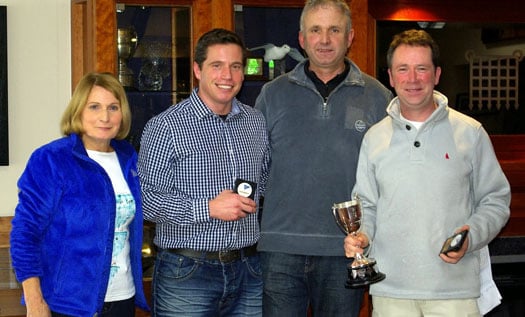
June Matthews, Rob Gill , KYC Commodore Finny O'Regan, Colm Dunne. Rob Gill & Colm Dunne receiving 1st place prize in the Squib Fleet.
The Prize winners were as follows:
Squib Class:
1st Allegro, Colm Dunne & Rob Gill KYC 2nd Lazurus, Colm Daly & Marcus Hutchinson KYC 3rd Fagin, Colm & Finny O'Regan KYC
Laser Full Rig Class:
1st Sean Murphy KYC
2nd James Long, Inniscarra
3rd Ian Travers KYC
Laser 4.7 Rig Class:
1st Billy Duane RCYC
2nd Ben Hunt KYC
3rd Jamie Tingle RCYC
Laser Radial Class:
1st Sorcha Ni Shuilleabhain KYC
2nd Cliodhna O'Regan KYC
3rd Sean Gambier-Ross KYC
Fireball Sailors Take Window of Opportunity in Dun Laoghaire
#fireball – Despite some of the most adverse weather forecasts I have heard for quite a while during Saturday, the Frostbites were sailed yesterday in almost balmy (for February) conditions, with sunshine, and a temperature of around 7 - 8º. The projected gale to strong gale to storm force (Beaufort 10) winds seemed to have evaporated!
The severe gales forecast for Sunday did not materialize and we were left with squally but very manageable conditions. As to be expected the rugby match taking place a few miles away took its toll on numbers but the DMYC offered to put up a recording of the game on their big screen to accommodate the racers.
Young Edward Coyne obviously had faith in the weather being favourable! He travelled up from Youghal with his mother to make not just his Frostbite debut but his Fireball Race debut, crewing for Alistair Court (14706) and was rewarded for his endeavours when they took the Frostbite Mug for the 2nd race of the day! Edward was one of the people who took part in our Open day on November 30th.
Two races were sailed yesterday and provided two formats for the fleet! Noel Butler and Kenny Rumball, crewed by Conor Kinsella and David Moran respectively matched-raced each other around both race courses to eventually share the spoils for the day, each having a win and a second place. Noel and Conor (15061) took the first race of the day, Kenny and David (15058) the second one. These two combinations only engaged with the fleet at the start lines and at the first weather marks, for the remainder of the races they were in their own world, quite separate from the rest of us.
Ten Fireballs started the first race and in the squally conditions it was quite difficult to work out which way to go. With the weather mark almost directly underneath the gantry for the HSS, in the wind shadow of the weather shore, the trapezing conditions of the bottom ⅔ of the beat were turned into a roll-tacking challenge to get to the mark. The trapezoid course could alternatively be described as a) a very shallow trapezoid or b) a four cornered triangle as Mark 2 was almost directly in transit between Marks 1 and 3. A slow start to the first spinnaker leg, under the lee of the gantry gave way to a much more exciting leg when the true wind was encountered.
In the first race, behind the lead two boats, the action was initially between Court/Coyne, Mick Creighton & Grattan Donnelly (14713), Neil Colin & Margaret Casey (14775) and Louis Smyth & Cormac Bradley (15007). As a late starter Team Clancy had to work their way up from the back of the fleet, but by the time the race ended they had got to third place. Creighton/Donnelly were having spinnaker problems from an early stage and retired, possibly prompted by the additional prospect of live TV rugby. Court & Coyne also dropped out of this group in the 2nd half of the 4-lap course to give a finishing order of;
1. Noel Butler & Conor Kinsella 15061 DMYC.
2. Kenny Rumball & David Moran 15058 INSC
3. Conor & James Clancy 14807 RStGYC
4. Neil Colin & Margaret Casey 14775 DMYC
5. Louis Smyth & Cormac Bradley 15007 Coal Harbour.
This gave Colin & Casey the first Frostbite Mug of the day!
The wind eased again for the second race, prompting this correspondent and his helm to go to light settings. Again there was a diversity of thought as to which side of the beat to work, the course having been unchanged form the first race. Butler and Rumball favoured the left hand side which is the direction most of the fleet took initially. However, the vagaries of the wind created an interesting situation at the top mark with Butler, Rumball, Smyth, Clancy and Colin all rounding almost bow to transom. They were quickly followed by Louise McKenna & Hermine O'Keeffe (14691) and the aforementioned Court & Coyne (14706). Rumball and Butler sped off to resume their match-racing from the first session. Team Clancy also got away from the bunch to effectively sail a comfortable race, distance-wise at least, never threatened from behind but never really closing on the lead pair.
Colin and Casey stayed ahead of the next three boats leaving Court, Smyth & McKenna fighting it out for the next place. Up the 2nd beat, Smyth went right initially having rounded behind the other two at Mark 4. This ultimately allowed him to get ahead of McKenna and close on Court but not enough to take Court on. In the fading breeze, the lighter crews were able to accelerate quicker than Smyth/Bradley when the gusts came through which meant that the latter combination had to work that bit harder to stay in touch.........which is exactly what Louise and Hermine were doing.
Up the last beat, Smyth & Bradley went left but again couldn't break the lead that Court & Coyne had over them. McKenna & O'Keeffe were also staying close. Court & Coyne held their lead over Smyth & Bradley to take the second Frostbite Mug of the day, with McKenna & O'Keeffe finishing behind them in turn.
1. Kenny Rumball & David Moran 15058 INSC
2. Noel Butler & Conor Kinsella 15061 DMYC
3. Conor & James Clancy 14807 RStGYC
4. Neil Colin & Margaret Casey 14775 DMYC
5. Alistair Court & Edward Coyne 14706 DMYC.
Frostbites 2013 – 2014, Dun Laoghaire Motor Yacht Club – Series 2 Overall
1 Kenny Rumball & David Moran 15058 INSC 6pts
2 Noel Butler & Stephen Oram/Conor Kinsella 15061 DMYC 9pts
3 Conor & James Clancy 14807 RStGYC 12pts
4 Neil Colin & Margaret Casey 14775 DMYC 23pts
5 Alistair Court & Gordon Syme/Edward Coyne 14706 DMYC 39pts
Dun Laoghaire & Kinsale Frostbite Sailing Cancelled Due to 'Orange Alert' Storm Warning
#frostbites – Thanks to weekend storms both east and south coast sailing frostbite series were cancelled yesterday. Dun Laoghaire Motor Yacht Club's Frostbite Dinghy harbour series was scrubbed and likewise on the south coast where Kinsale's renowned sheltered harbour was no match for the south westerly gale that prompted an orange alert warning from Met Eiereann and the Coast Guard.
Both series are expected to resume next Sunday.




























